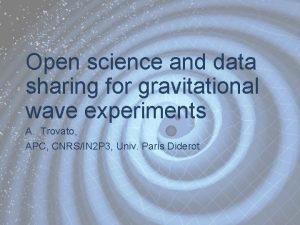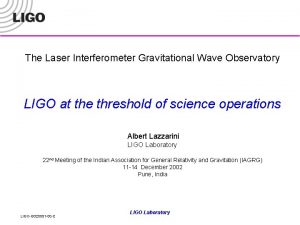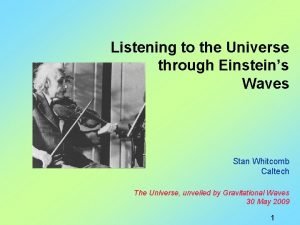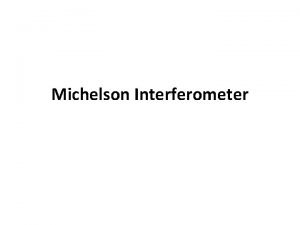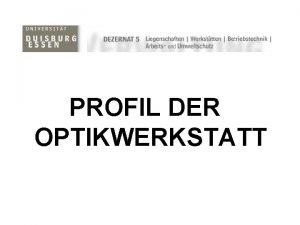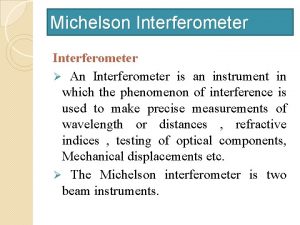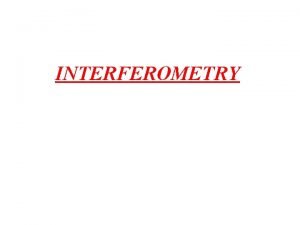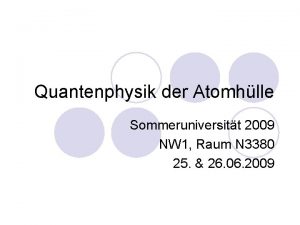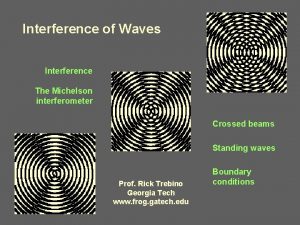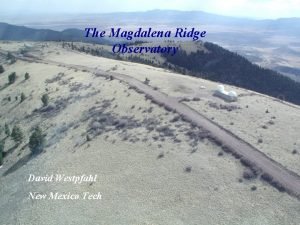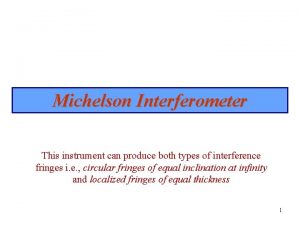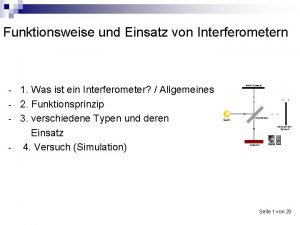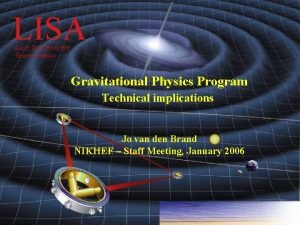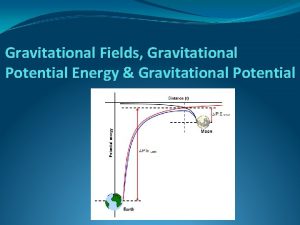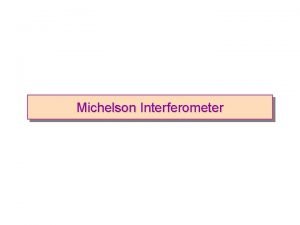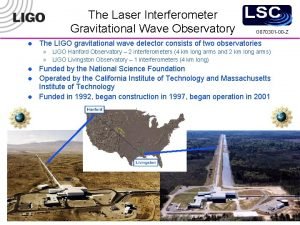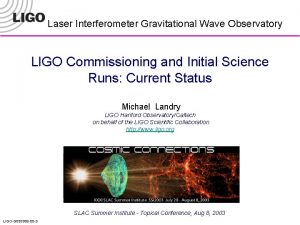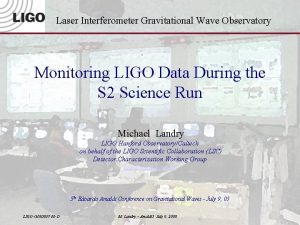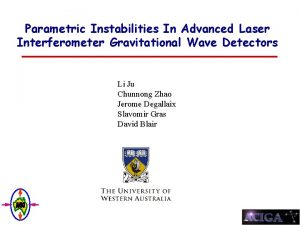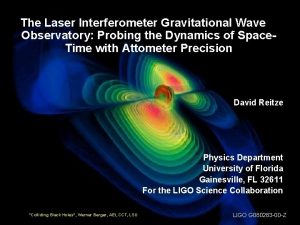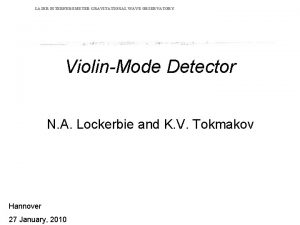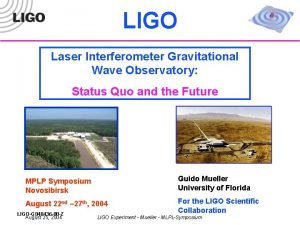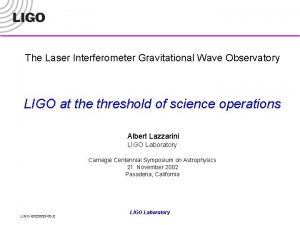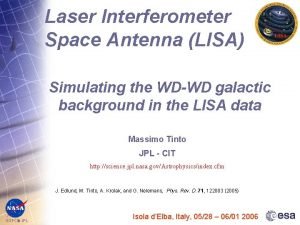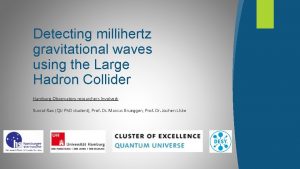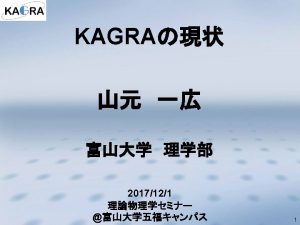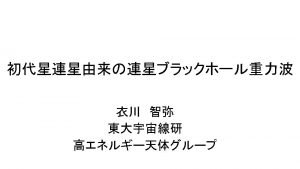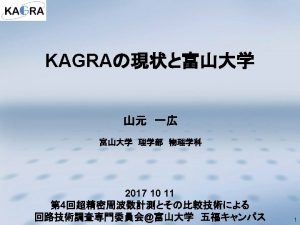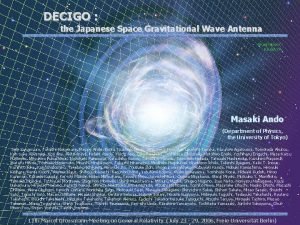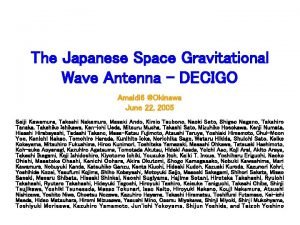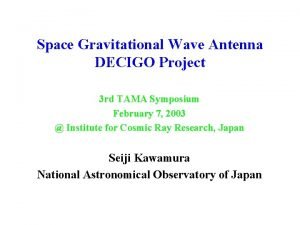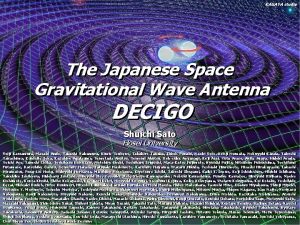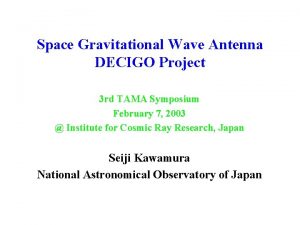The Laser Interferometer Space Antenna Millihertz gravitational wave



































- Slides: 35

The Laser Interferometer Space Antenna: Millihertz gravitational wave science John Baker, NASA/GSFC GWADW 2018 Gridwood, AK - 13 May 2018

LISA: Opening the millihertz band Stronger gravity Numerous sources Baker, NASA/GSFC GWADW 2018 2

LISA science in milli-Hz band • Science Objectives: • Trace the formation, growth, and merger history of massive black holes • Explore stellar populations and dynamics in galactic nuclei • Test General Relativity with observations • Probe new physics and cosmology • Survey compact stellar-mass binaries and study the structure of the Galaxy Credit: M. Hewitson / LISA Consortium LISA is sensitive to signals above dashed V-shaped curve Baker, NASA/GSFC GWADW 2018 - Gridwood, AK - 13 May, 2018 3

Trace the formation, growth, and merger history of massive black holes 4

SO 2: Trace the origin, growth and SI 2. 1 Search for seed black holes at cosmic dawn merger history of massive black holes across cosmic ages SI 2. 2 Study the growth mechanism of MBHs from the epoch of the earliest quasars OR 2. 1 Have the capability to detect the inspiral of MBHBs in the interval between a few 103 M⊙ and a few 105 M⊙ in the source frame, and formation 10 < z < 15. Enable the measurement of the source frame masses and the luminosity distance with a fractional error of 20% to distinguish formation models. OR 2. 2. a Have the capability to detect the signal for co- alescing MBHs with mass 104 < M < 106 M⊙ in the source frame at z ≲ 9. Enable the measurement of the source frame masses at the level limited by weak lensing (5 %). OR 2. 2. b For sources at z<3 and 105 <M<106 M⊙, enable the measurement of the dimensionless spin of the largest MBH with an absolute error better than 0. 1 and the detection of the misalignment of spins with the orbital angular momentum better than 10 deg, corresponding to an accumulated SNR (up to the merger) of at least ∼ 200. SI 2. 3 Observation of EM counterparts to unveil the astrophysical environment around merging binaries OR 2. 3. a Observe the mergers of Milky-Way type MBHBs with total masses between 106 and 107 M⊙ around the peak of star formation (z ∼ 2), with sufficient SNR to allow the issuing of alerts to EM observatories with a sky-localisation of 100 deg 2 at least one day prior to merger. OR 2. 3. b Observe the OR 2. 3 a sources with excellent post-merger sky localisation (about 1 deg 2) to distinguish from other variable EM sources in the field months to years after the merger. SI 2. 4 Test the existence of Intermediate Mass Black OR 2. 4. a Have the ability to detect the inspiral from nearly equal mass Hole Binaries (IMBHBs) IMBHBs of total intrinsic mass between 600 and 104 M⊙ at z < 1, measuring the com- ponent masses to a precision of 30%, which requires a total accumulated SNR of at least 20. OR 2. 4. b Have the ability to detect unequal mass MBHBs of total intrinsic mass 104− 106 M⊙ at z<3 with the lightest black hole (the IMBH) in the intermediate mass range (between 102 and 104 M⊙), measuring the component masses to a precision of 10%, which requires a Source: LISA Mission Proposal. Note actual mission science requirements may evolve. total accumulated SNR of at least 20. 5

Massive Black Hole Binaries • Sources • • • Mergers of BHs with mass of 104 ~ 107 M☉ Measurements • ~102 detections w/ 10≲ SNR ≲ 10 4 • parameter accuracy scales w/ SNR • 0. 01% ≲ δM/M ≲ 1% , 3% ≲ δD/D ≲ 10% • 2 ≲ δA ≲ 10 deg 2 0. 01% ≲ δΧ/Χ ≲ 1%, 10 arcmin Science • BH merger history over cosmic time • Origin of BH seeds • Precision tests of general relativity Baker, NASA/GSFC GWADW 2018 6

Modeling MBH binary astrophysics

Trace the formation, growth, and merger history of MBHs • Contours: LISA Sensitivity • Tracks: formation of MBH systems purple: from large seed to z~6 quasar yellow: from Pop III seed z~6 quasar red: to 109 M☉ in giant elliptical green: to Milky-way like MBH circles: merger events • Example LISA measures: A proposed future ground-based instrument masses -err < 5% for at z~9 for 104 < M < 106 M⊙ spins -err < 0. 1 for at z~3 for 105 < M < 106 M⊙ distances -err < 20% at z ~15 for 105 < M < 106 M⊙ Baker, NASA/GSFC GWADW 2018 Credit: N. Cornish, M. Hewitson, and the LISA and ET Teams. Created for the Gravitational Wave International Committee (GWIC). Tracks as in Gravitational Universe science theme document (2013) 8

Explore stellar populations and dynamics in galactic nuclei 9

SO 3: Probe the dynamics of dense nuclear clusters using EMRIs SI 3. 1 Study the immediate environment of Milky Way like MBHs at low redshift OR 3. 1 Source: LISA Mission Proposal. Note actual mission science requirements may evolve. 10 Have the ability to detect EMRIs around MBHs with masses of a few times 105 M⊙ out to red- shift z = 4 (for maximally spinning MBHs, and EMRIs on prograde orbits) with the SNR ≥ 20. This enables an estimate of the redshifted, observer frame masses with the accuracy δM/M < 10− 4 for the MBH and δm/m < 10− 3 for the SOBH. Estimate the spin of the MBH with an accuracy of 1 part in 103, the eccentricity and inclination of the orbit to one part in 103.


Extreme Mass Ratio Inspirals • Sources • Stellar remnant BHs captured by MBHs in nuclear clusters • Mass ratio of 1000: 1 or greater (difficult modeling & analysis) • Measurements • Uncertain rates: 1 yr-1 ≲ REMRI ≲ 1000 yr-1 • Rough extrinsic parameters (δD/D~10%, δΑ~10 deg 2) • Exquisite intrinsic parameters (δM/M ~ 0. 01%, δΧ/Χ~0. 01%, etc) • Science • Demographics of stellar remnant BHs in nuclear clusters • Precision MBH measurements. • Precision tests of general relativity Baker, NASA/GSFC GWADW 2018 12

Source: Slide from Alberto Sesana Baker, NASA/GSFC GWADW 2018 Gair EA 2017 13

Left: The complicated precession motion of BH falling into an MBH yields structured GWs carrying precise information about the system. Right: parameter estimation precision for e. LISA observations drawn from a simulated EMRI

Source: Slide from Alberto Sesana Baker, NASA/GSFC GWADW 2018 15

Survey compact stellar-mass binaries and study the structure of the Galaxy 16

SO 1: Study the formation and SI 1. 1 Elucidate the formation and evolution of GBs OR 1. 1. a To survey the period distribution of GBs, and have the capability evolution of compact binary stars by measuring their period, spatial and mass to distinguish between ∼ 5000 systems with inferred period in the Milky Way Galaxy. distributions. precision δP/P < 10− 6 OR 1. 1. b To measure the mass, distance and sky lo- cation for the majority of these GBs with frequency f > 3 m. Hz, chirp mass > 0. 2 M⊙ and distance < 15 kpc OR 1. 1. c: To detect the low frequency galactic confu- sion noise in the frequency band from 0. 5 to 3 m. Hz. SI 1. 2 Enable joint gravitational and electromagnetic OR 1. 2. a To detect ∼ 10 of the currently known verification binaries, observations of GBs to study the interplay inferring periods with accuracy δP/P < 10− 6 between gravitational radiation and tidal dissipation in interacting stellar systems. OR 1. 2. b To enable identification of possible electro- magnetic counterparts, determine the sky location of ∼ 500 systems within one square degree. OR 1. 2. c To study the interplay between gravitational damping, tidal heating, and to perform tests of GR, localise ∼ 100 systems within one square degree and determine their first period derivative to a fractional accuracy of 10% or better. Source: LISA Mission Proposal. Note actual mission science requirements may evolve. 17

Galactic Binaries • • • Baker, NASA/GSFC Sources • Millions of compact binaries (WD, NS, BH) in Milky Way • mono- or quasi-mono-chromatic Measurements • millions unresolved foreground • ~2 x 104 individually resolved • δM/M~1%, δD/D~3%, δA~10 deg 2 Science • Binary demographics (WD-WD vs. AM CVn vs. NS-WD, etc. ) • Galactic structure in WD binaries GWADW 2018 18

Baker, NASA/GSFC GWADW 2018 19

Known LISA verification binaries Kupfer et al 2018 Baker, NASA/GSFC GWADW 2018 20

LISA Observations of Galactic Binaries Above: LISA measurements of resolved Galactic binaries for sources with SNR>20, observed for 4 years. Below: Estimated rates Cornish-Robson 2017. Unresolved GW foreground from Galactic binaries. Cornish-Robson 2017.

SO 4: Understand the astrophysics of stellar origin black holes SI 4. 1 Study the close environment of SOBHs by enabling multi-band multi-messenger observations at the time of coalescence OR 4. 1 Have the ability to detect the inspiral signal from GW 150914 -like events with SNR > 7 after 4 years of observation and estimate the sky localisation with < 1 deg 2 and the time of coalescence in ground-based detectors to within one minute. This will allow the triggering of alerts to ground-based detectors and to pre-point EM probes at the SOBH coalescence. SI 4. 2 Disentangle SOBH binary formation channels OR 4. 2 Have the ability to observe SOBH binaries with total mass in excess of 50 M⊙ out to z ~ 0. 1, with an SNR higher than 7 and a typical fractional error on the mass of 1 part in 100 and eccentricity with an absolute error of 1 part in 103. Source: LISA Mission Proposal. Note actual mission science requirements may evolve. 22

BH binaries & multi-band GW astronomy • Sources A. Sesana, Phys. Rev. Lett. 116, 231102 The SXS Project • Baker, NASA/GSFC • Heavy stellar remnant BH binaries (e. g. GW 150914) • LISA will observe for months to years prior to merger. • gap of ~weeks between LISA and LIGO Science • Advance notice of when and where BH merger will occur. Counterpart? • Compare LISA and ground-based GW waveforms. GW dispersion? GWADW 2018 23

Source: Slide from Alberto Sesana Baker, NASA/GSFC GWADW 2018 24

Test General Relativity with observations 25

SO 5: Explore the fundamental SI 5. 1 Use ring-down characteristics observed in OR 5. 1 nature of gravity and black holes MBHB coalescences to test whether the postmerger objects are the black holes predicted by GR. Have the ability to detect the post-merger part of the GW signal from MBHBs with M > 105 M⊙ out to high redshift, and observe more than one ring-down mode to test the “no-hair” theorem of GR. SI 5. 2 Use EMRIs to explore the multipolar structure OR 5. 2 of MBHs Have the ability to detect ‘Golden’ EMRIs (those are systems from OR 3. 1 with SNR > 50, spin > 0. 9, and in a prograde orbit) and estimate the mass of the SOBH with an accuracy higher than 1 part in 104, the mass of the central MBH with an accuracy of 1 part in 105, the spin with an absolute error of 10− 4, and the deviation from the Kerr quadrupole moment with an absolute error of better than 10− 3. SI 5. 3 Testing for the presence of beyond-GR emission channels OR 5. 3 Same as OR 4. 1 SI 5. 4 Test the propagation properties of GWs OR 5. 4 Same as combination of ORs 2. 2 and 3. 1. SI 5. 5 Test the presence of massive fields around massive black holes with masses > 103 M⊙ OR 5. 5 Same as combination of ORs 2. 2, 4. 1 and 4. 2 Source: LISA Mission Proposal. Note actual mission science requirements may evolve. 26

GW Dispersion test Samajdar+Arun 2017 ��=0 : massive graviton ��=2. 5 or 3 : Lorentz violations 27

Probe new physics and cosmology 28

SO 6: Probe the rate of expansion SI 6. 1 Measure the dimensionless Hubble of the Universe parameter by means of GW observations only OR 6. 1. a Have the ability to observe SOBH binaries with total mass M>50 M⊙ at z<0. 1 with SNR higher than 7 and typical sky location of < 1 deg 2. OR 6. 1. b Have the ability to localize EMRIs with an MBH mass of 5× 105 M⊙ and an SOBH of 10 M⊙ at z = 1. 5 to better than 1 deg 2. SI 6. 2 Constrain cosmological parameters through joint GW and EM observations SO 7: Understand stochastic GW SI 7. 1 Characterise the astrophysical stochastic backgrounds and their GW background implications for the early Universe and Te. V-scale particle physics SO 8: Search for GW bursts and unforeseen sources OR 6. 2 Have the capability to observe mergers of MBHBs in the mass range from 105 to 106 M⊙ at z < 5, with accurate parameter estimation and sky error of < 10 deg 2 to trigger EM follow ups. OR 7. 1 Characterise the stochastic GW background from SOBH binaries with energy density normalised to the critical energy density in the Universe today, Ω, based on the inferred rates from the LIGO detections, i. e. , at the lowest Ω = 2 × 10− 10 ( f /25 Hz)2/3. This requires the ability to verify the spectral shape of this stochastic background over the frequency range 0. 8 m. Hz < f < 4 m. Hz and to measure its amplitude over 4 m. Hz < f < 20 m. Hz. SI 7. 2 Measure, or set upper limits on, the spectral OR 7. 2 shape of the cosmological stochastic GW background Probe a broken power-law stochastic background from the early Universe. Therefore, we need the ability to measure Ω = 1. 3 × 10− 11 ( f /10− 4 Hz)− 1 in the frequency ranges 0. 1 m. Hz < f < 2 m. Hz, and Ω = 4. 5 × 10− 12 (f/10− 2 Hz)3 in the frequency ranges 2 m. Hz < f < 20 m. Hz. SI 8. 1 Search for cusps and kinks of cosmic strings OR 8. 1 Have the ability to use the Sagnac (or null-stream) TDI channels. OR 8. 2 Have the ability to use the Sagnac (or null-stream) TDI channels. Source: LISA Mission Proposal. Note actual mission science requirements may evolve. 29

Black Hole Cosmology • • BH mergers as “standard sirens” • chirp rate gives mass • mass gives intrinsic amplitude • measured amplitude gives distance Redshift • Need EM follow-up to identify (or constrain) hosts Luminosity distances for simulated catalog of LISA BH binaries (N. Tamanini) Baker, NASA/GSFC GWADW 2018 30

LISA Science Now 31

Baker, NASA/GSFC • Science Status Overview • Source: LISA Science Roadmap NASA L 3 Study Team 2017 Preliminary GWADW 2018 32

Baker, NASA/GSFC • The new LISA Consortium: • Roles -LISA Instrument payload -Science data processing -Science community • Reorganized for Phase-A • Processing Membership Applications ~125 group applications ~800 individual members GWADW 2018 33

The LISA Data Challenges • 2006 -2011 Mock LISA Data Challenges • • • Baker, NASA/GSFC Demonstrated proof-of-concept LISA data analysis LDC LISA Phase A Project Goals: • Project oriented challenges: Moving away from idealized data • Demonstrate capability to deliver science requirements • Understand the nature of data analysis needs for project planning • Develop software standards and pipelines Broader LISA data analysis research goals: • Foster LISA data analysis development: improve performance of existing algorithms, try new algorithms • Community oriented challenges / tutorials GWADW 2018 - Gridwood, AK - 13 May, 2018 34

• Contact US reps. on ESA’s Science Study Team LISA wants you! —Kelly Holley-Bockelmann / Vanderbilt —Robin Stebbins / Colorado —David Shoemaker / MIT • Participate in the LDC: Sign up here: https: //lisa-ldc. lal. in 2 p 3. fr/ldc —Participate in the public challenges: —Join the LDC team: (first join the Consortium) • Join the LISA Consortium: Sign up here: www. LISAmission. org —Now reorganizing to deliver results for LISA Phase A … technology development, instrument simulations, data challenges —Can sign-on to join the effort —Or just as a curious observer Baker, NASA/GSFC • Engage with the NASA LISA Study Team: —Bringing LISA through the US astro decadal survey —Write great science white papers! • Eng LISA Preparatory Science (LPS) in NASA ROSES —NOIs were due last month —Be a reviewer! A proposed future ground-based instrument GWADW 2018 - Gridwood, AK - 13 May, 2018 35
 Laser interferometer space antenna
Laser interferometer space antenna Gravitational wave open science center
Gravitational wave open science center Giant gravitational wave detectors hear murmurs
Giant gravitational wave detectors hear murmurs Gravitational wave
Gravitational wave Gravitational wave
Gravitational wave Giant wave murmurs across universe
Giant wave murmurs across universe Cara kerja interferometer michelson
Cara kerja interferometer michelson Optikwerkstatt
Optikwerkstatt What is the principle of michelson interferometer
What is the principle of michelson interferometer Pitter npl gauge interferometer
Pitter npl gauge interferometer Mach-zehnder-interferometer leifi
Mach-zehnder-interferometer leifi Michelson interferometer formula
Michelson interferometer formula Magdalena ridge observatory interferometer
Magdalena ridge observatory interferometer Types of fringes in michelson interferometer
Types of fringes in michelson interferometer Weißlichinterferometer funktionsweise
Weißlichinterferometer funktionsweise Mechanical and electromagnetic waves
Mechanical and electromagnetic waves Center tapped rectifier
Center tapped rectifier The wave chapter 10
The wave chapter 10 Difference between full wave and half wave rectifier
Difference between full wave and half wave rectifier Wavelength formula triangle
Wavelength formula triangle P and s wave chart
P and s wave chart Even symmetry fourier series
Even symmetry fourier series Longitudinal vs transverse waves
Longitudinal vs transverse waves Full wave rectified sine wave fourier series
Full wave rectified sine wave fourier series Longitudinal wave vs transverse wave
Longitudinal wave vs transverse wave Electromagnetic and mechanical waves
Electromagnetic and mechanical waves Half full wave rectifier
Half full wave rectifier A ____ is a repeating disturbance or movement that
A ____ is a repeating disturbance or movement that Short wave vs long wave radiation
Short wave vs long wave radiation Space junk the space age began
Space junk the space age began Camera space to world space
Camera space to world space Cartesian space vs joint space
Cartesian space vs joint space Unscented trajectory chapter 5
Unscented trajectory chapter 5 World space computer
World space computer Công thức tính độ biến thiên đông lượng
Công thức tính độ biến thiên đông lượng Phép trừ bù
Phép trừ bù

